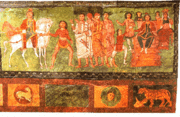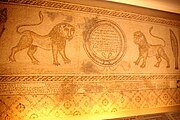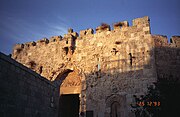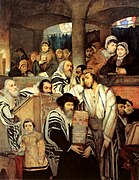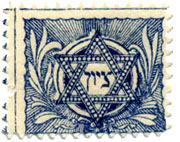Diferencia entre revisiones de «Usuario:Calimeronte/taller»
Apariencia
Contenido eliminado Contenido añadido
| Línea 88: | Línea 88: | ||
* Judaica |
* Judaica |
||
* Sumo Sacerdote de Israel - existe sólo como Anexo:Sumos Sacerdotes de Israel |
* Sumo Sacerdote de Israel - existe sólo como Anexo:Sumos Sacerdotes de Israel |
||
* Szyk - [[:en:Arthur Szyk|Arthur Szyk]] — [https://en.wikipedia.org/wiki/File:Arthur_Szyk02.jpg| Rubáiyát of Omar Khayyám 1940] ([[:en:https://en.wikipedia.org/wiki/Rubaiyat_of_Omar_Khayyam|poesía persa siglos XI-XII]]) ; [https://en.wikipedia.org/wiki/File:%27Battle_of_the_Warsaw_Ghetto%27_by_Arthur_Szyk,_1945.jpg| Batalla del Gueto de Varsovia 1945] ; [https://en.wikipedia.org/wiki/File:Arthur_Szyk09.jpg Hagadá 1956] ; [https://en.wikipedia.org/wiki/File:Eleanor_Roosevelt_and_Arthur_Szyk_-_NARA_-_195394.jpg IL.TXT 1956]. |
* Szyk - [[:en:Arthur Szyk|Arthur Szyk]] — [https://en.wikipedia.org/wiki/File:Arthur_Szyk02.jpg| Rubáiyát of Omar Khayyám 1940] ([[:en:https://en.wikipedia.org/wiki/Rubaiyat_of_Omar_Khayyam|poesía persa siglos XI-XII]]) ; [https://en.wikipedia.org/wiki/File:%27Battle_of_the_Warsaw_Ghetto%27_by_Arthur_Szyk,_1945.jpg| Batalla del Gueto de Varsovia 1945] ; [https://en.wikipedia.org/wiki/File:Arthur_Szyk09.jpg Hagadá 1956] ; [https://en.wikipedia.org/wiki/File:Eleanor_Roosevelt_and_Arthur_Szyk_-_NARA_-_195394.jpg IL.TXT 1956] ; [http://www.szyk.com/ sitio oficial]. |
||
==Compilación material a ser incluido en entradas diversas== |
==Compilación material a ser incluido en entradas diversas== |
||
Revisión del 02:59 23 jun 2014
Esta es mi zona de pruebas. Es subpágina de mi página de usuario y me sirve para hacer pruebas. Ella no es un artículo de la enciclopedia. Solicito no modificarla. Gracias, Calimeronte
Trabajados
- Arte judío
- Arte asquenazí
- Beth Hatefutsoth
- Cristo en el judaísmo
- Cristo entre los doctores
- Diez Mandamientos
- Estrella de David
- Éxodo
- Golem
- Gottlieb - Maurycy Gottlieb
- Habiru
- Hebreos
- Historia de los judíos
- Insignia amarilla
- La fuente de la gracia
- Liebermann - Max Liebermann
- Lilien - Ephraim Moses Lilien
- Menorá
- Museo de Israel, Jerusalén
- Santa María la Blanca
- Sinagoga Hurva
- Sumo Sacerdote - Anexo:Sumos Sacerdotes de Israe
- Templo de Jerusalén
- Yidis
Trabajados eventualmente
- Abraham
- Arte sefardí
- Biblia de Alba
- Crónicas de Núremberg
- Doce Tribus de Israel
- Dybbuk
- Gótico español
- Hartmann Schedel
- Israelita
- Jehú
- Judaísmo y cristianismo
- Macabeos
- Mevaseret Sion
- Modernismo (arte)
- Obelisco Negro
- Oseas
- Palmaj
- Sinagoga
- Tabernáculo
- Tierra Prometida
- Pogromo de Kishinev
Aún sin trabajar
- Agam - Yaacob Agam
- Arca de la Alianza
- Biblia hebrea
- Chagall - Marc Chagall
- Diáspora sefardí
- Diez Mandamientos
- Divisiones étnicas judías
- Dura Europos
- Gueto
- Hagadá
- Hebreo - Idioma hebreo
- Hilel
- Historia de los judíos
- Historia de los judíos en España
- Historia de los judíos en la Tierra de Israel
- Historia del Antiguo Israel
- Holocausto
- Homaranismo - Hilelismo
- Israëls - Jozef Israëls
- Mendelsohn - Erich Mendelsohn
- Museo de Arte y de Historia del Judaísmo, París
- Oppenheim - Moritz Daniel Oppenheim
- Pueblo judío
- Sion
- Solución final
- Sucot
- Talmud
- Tanaj
- Teoría del reemplazo
- Tierra Santa
- Tribus de Israel
- Zona de Asentamiento
A ser creados
- Bak - Samuel Bak
- Judaica
- Sumo Sacerdote de Israel - existe sólo como Anexo:Sumos Sacerdotes de Israel
- Szyk - Arthur Szyk — Rubáiyát of Omar Khayyám 1940 (poesía persa siglos XI-XII) ; Batalla del Gueto de Varsovia 1945 ; Hagadá 1956 ; IL.TXT 1956 ; sitio oficial.
Compilación material a ser incluido en entradas diversas

-
Moisés con los Diez Mandamientos
-
Las Doce Tribus de Israel, 1200-1050 a.EC.
-
Reinos de Israel y Judá, 926 a.EC.
-
Exilio babilónico. Deportación de los judíos del Reino de Judá a Babilonia tras la destrucción del Templo de Salomón (Tissot, 1896-1902)
-
Segundo Templo de Jerusalén
-
Fragmentos arqueológicos judaico y romano. Fotografiados por Auguste Salzmann en 1853.
-
Sitio y destrucción de Jerusalén por los romanos, 70 EC (Roberts, 1850)
-
Espolios de Jerusalén, 70 EC
-
Dura Europus, 244 EC
-
Moisés, Dura Europus, 244-256
-
Mosaico del Sinagoga de Beit Alfa, siglo V
-
Mosaico en la Sinagoga de Seforis, siglo V
-
Mosaic proveniente de la Sinagoga de Hamat Gader, siglo V-VI
-
Mosaico con Menorá, lulav y etróg, siglo VI.
-
Llegada de los judíos a Polonia, 1096 (Jan Matejko, s. XIX).
-
Los cruzados capturan Jerusalén, 1099
-
Hagadá Barcelona, s. XIV, fol. 42v
-
Hagadá Cataluña, s. XIV. Versificación: "Ilu... ve lo..."
-
Puerta de Sion, Jerusalén, 1540
-
Judíos asquenazíes rezando en una sinagoga, s. XIX (Gottlieb)
-
Emancipación de los judíos, 1806
-
Liebermann, Jesús en el Templo, 1879
-
Degradación de Alfred Dreyfus (Le Petit Journal, 1895).
-
Musée des Horreurs: Le Traître, litografía, 1899
-
Sion, 1901-2
-
La calle Hester, Nueva York, 1903
-
Emigrantes, c. 1920
-
Auschwitz: "El trabajo libera".
-
Europa: Holocausto
-
Ivangorod, 1942
-
Buchewald, 1945
-
Mandato Británico de Palestina, 1920
-
Guardia de un kibbutz, 1936
-
Plan de la ONU para la división de Palestina, 1947
-
Puerta de Sion, después de la Guerra árabe-israelí de 1948
-
Arthur Szyk, Estampilla, 1950.
-
Idem
-
Israel y los territorios en litigio, 2005
Recursos a ser incorporados
Material a traducir y explorar su imaginería:
- Washington, D.C., Library of Congress, Arthur Szyk: Artist for Freedom, diciembre de 1999-mayo de 2000; accedido 22 de junio de 2014. Arthur Szyk (1894 - 1951) was one America's leading political artists during World War II, when he produced hundreds of anti-Axis illustrations and cartoons in aid of the Allied war effort. Throughout his career he created art in the service of human rights and civil liberties -- in his native Poland, in Paris where he was trained during the 1920s, and in America, the country he adopted in 1940. Settling in the United States, Szyk announced, "At last, I have found the home I have always searched for. Here I can speak of what my soul feels. There is no other place on earth that gives one the freedom, liberty and justice that America does." / Born of Jewish parents in Lodz, Poland, Szyk acquired his early art training in Paris and Cracow. Between 1919 and 1920, during Poland's war against the Soviet Bolsheviks, he served as artistic director of the Department of Propaganda for the Polish army regiment quartered in Lodz. In 1921, he moved to Paris where he lived and worked for ten years. In 1934, Szyk traveled to the United States for exhibitions of his work, including one at the Library of Congress where a series of thirty-eight miniatures commemorating George Washington and the Revolutionary period were shown. In late 1940, after a period of residence in England, he immigrated to the United States. / In America, Arthur Szyk embraced the patriotic and democratic spirit of his adopted country. His work entitled The United States of America, includes portrayals of an African American and Native American, representing the diversity of American society, as well as familiar imagery -- Hoover Dam, the Manhattan skyline, the Golden Gate Bridge, and the Pony Express. His anti-Axis cartoons appeared frequently in such popular magazines as Collier's and in two published compilations, The New Order (1941) and Ink & Blood (1946). He also illustrated numerous works, including a richly rendered, magnificently printed Haggadah (1940), reflecting his passion for his own Jewish heritage and concern for the Jewish people in the face of Nazi hostility.
- Washington, D.C., Library of Congress, Scrolls from the Dead Sea: The Ancient Library of Qumram and Modern Scholarship, abril-agosto de 1993; accedido 22 de junio de 2014. The exhibition Scrolls From the Dead Sea: The Ancient Library of Qumran and Modern Scholarship brings before the American people a selection from the scrolls which have been the subject of intense public interest. Over the years questions have been raised about the scrolls' authenticity, about the people who hid them away during the period in which they lived, about the secrets the scrolls might reveal, and about the intentions of the scrolls' custodians in restricting access. The Library's exhibition describes the historical context of the scrolls and the Qumran community from whence they may have originated; it also relates the story of their discovery 2,000 years later. In addition, the exhibition encourages a better understanding of the challenges and complexities connected with scroll research.
- Washington, D.C., Library of Congress, Words Like Sapphires: 100 Years of Hebraica at the Library of Congress, 1912–2012, octubre de 2012-abril de 2013; accedido 22 de junio de 2014. The Hebraic Section of the Library of Congress is recognized as one of the world’s foremost centers for the study of Hebrew and Yiddish materials. Its beginnings can be traced to Jacob H. Schiff’s gift in 1912 of nearly 10,000 books and pamphlets. In the century since Schiff’s initial gift, the Library has expanded its Hebraic holdings to close to 200,000 works in Hebrew and related languages.
Referencia bíblica
Ayuda
- Tablón de bibliotecarios
- Jkbw (berlín)
- Aviador (reversor)
- Lourdes (supresora)








